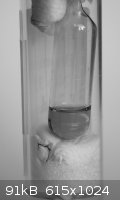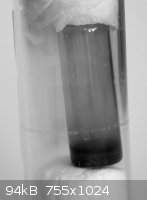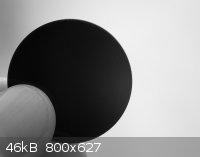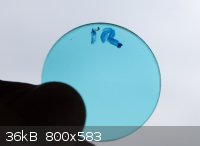| Pages:
1
2
3
4 |
12AX7
Post Harlot
    
Posts: 4803
Registered: 8-3-2005
Location: oscillating
Member Is Offline
Mood: informative
|
|
Quote: Originally posted by Finnnicus  | | I'm not sure I understand (always learning), in the photo, red/bromine colored wavelengths have been removed? If this is true, does everything have a
particular set of wavelengths associated with it? |
Yes. Being made of electrons and quantum mechanics, photons can be absorbed when there's an allowed energy transition from the resting state (usually
the lowest energy state, since room temperature isn't much energy to begin with).
Most insulators are transparent from DC to THz, and most conductors are opaque to reflective from DC to THz. At these frequencies, classical analysis
suffices (electrical conductivity, dielectric constant, relative permeability, etc.).
At higher frequencies (far IR to UV), depending on the material, different things happen. Often, the change can still be expressed in a reasonable
way in classical terms -- the waves are changing quite fast, so the electrons in the material exhibit phase shift, which causes loss or unusual phase
shifts; modeling a dielectric as a capacitor, on its most reduced level (i.e., the material property of capacitance), breaks down and complicated
substitutions take over. As the degrees of freedom go up, you pretty much have to resort to empirical data from which to construct your model, and
the model value diminishes.
When you start talking materials with resonances, you're about as well off as using the quantum idea -- a resonance (an absorption or transmission
line) relates to energy level transitions. Materials we think of as transparent are, of course, only transparent where we can see them; this occurs
in insulators with a bandgap over 3eV. Lower bandgaps appear yellow, orange or reddish (try looking at the die in a green LED that has a clear lens),
until the bandgap is so low that all incident visible light is simply reflected or absorbed. Silicon, with a bandgap of 1.1eV, appears shiny in
visible light, but is transparent over the medium to far IR band. Quartz has a bandgap over 8eV, hence its used in UV lamps.
At even higher energies, atoms don't always act together; a UV or x-ray photon can strike the material and knock an electron out in a very quantum
way. Photons of any energy are still waves, of course, so you can still set up experiments with diffraction and such (hence XRD and x-ray lenses,
which are made using grazing angle optics).
Tim
|
|
|
12AX7
Post Harlot
    
Posts: 4803
Registered: 8-3-2005
Location: oscillating
Member Is Offline
Mood: informative
|
|
And to bring that around to the present subject, bromine I suspect is something like liquid gallium arsenide: a semiconductor with a bandgap in the
near IR (hence its use in ~900 nm LEDs and such), it looks black under visible light. Related alloys, like AlGaAsP, with incrementally higher
bandgaps, look brown to reddish: red, orange and yellow LEDs are made of these materials. The reflection/absorption spectrum is probably very close
to that of bromine.
The molecular density (for being a somewhat ionically bonded crystal) and index of refraction are probably higher for GaAs alloys than for Br, so they
would tend to be exaggerated in darkness, blackness, and metallic luster, relative to Br.
Tim
|
|
|
Finnnicus
Hazard to Others
  
Posts: 342
Registered: 22-3-2013
Member Is Offline
|
|
Tim, I know someday I'll understand. Today is not that day, thanks for trying.
|
|
|
Endimion17
International Hazard
    
Posts: 1468
Registered: 17-7-2011
Location: shores of a solar sea
Member Is Offline
Mood: speeding through time at the rate of 1 second per second
|
|
Quote: Originally posted by Finnnicus  | Ah so it is really dependent on the substance, not how it looks. Bromine's behavior under NIR is somewhat unrelated to the evil red color?
Could this be done with mercury? Why/why not? How would I found out for myself? |
The visible characteristics of a substance depend on the structure (chemical and physical), the radiation used to capture information, and the way we
register transmitted, emitted and reflected radiation.
Its deep, evil red color is exactly like that - somewhat unrelated. It's merely a hint. There is no magical border between deep red and NIR in the
reality, so it would be expected that absorption graphs don't just skyrocket right there.
There might be materials completely opaque to some NIR, yet transparent for frequencies we perceive as red.
Mercury is not only a metal, but a liquid metal. Electrons are responsible for the colors (their clouds affect photons), and as I've said, metals are
cationic cages in electron gas. If you turn that cage into a mush, there's no way anything can get through. Mercury is black on transmittion. It has
no color.
Mercury vapor, on the other hand, is atoms. I think it's transparent in any IR spectrum. It's transparent in visible spectrum, too, but it absorbs in
UV-C, so you can shine it towards a screen that will glow in visible light when struck by UV-C photon, and put mercury vapor between, revealing a vapor casting shadow.
|
|
|
Finnnicus
Hazard to Others
  
Posts: 342
Registered: 22-3-2013
Member Is Offline
|
|
That I understand, Tim is just out of my league hehe
|
|
|
DraconicAcid
International Hazard
    
Posts: 4278
Registered: 1-2-2013
Location: The tiniest college campus ever....
Member Is Offline
Mood: Semi-victorious.
|
|
Quote: Originally posted by Endimion17  | | Mercury is not only a metal, but a liquid metal. Electrons are responsible for the colors (their clouds affect photons), and as I've said, metals are
cationic cages in electron gas. If you turn that cage into a mush, there's no way anything can get through. Mercury is black on transmittion. It has
no color. |
If you pound gold thin enough, you can pass light through it (I've read that it's green by transmission, but of course, it's not in the book where I
thought I read it, so I can't give a reference). Could you squeeze mercury thin enough to get some light to pass through?
Please remember: "Filtrate" is not a verb.
Write up your lab reports the way your instructor wants them, not the way your ex-instructor wants them.
|
|
|
Endimion17
International Hazard
    
Posts: 1468
Registered: 17-7-2011
Location: shores of a solar sea
Member Is Offline
Mood: speeding through time at the rate of 1 second per second
|
|
Quote: Originally posted by DraconicAcid  | | If you pound gold thin enough, you can pass light through it (I've read that it's green by transmission, but of course, it's not in the book where I
thought I read it, so I can't give a reference). Could you squeeze mercury thin enough to get some light to pass through? |
Very thin metallic films are extreme cases cause it's just few cations thick. Yes, gold is greenish-blue on transmission, but that's probably because
of its more complex orbital situation. When you include d-orbitals, you have a lot of work to do. 
Aluminium does not have d-orbitals, so its films behave like extremely powerful neutral density filters. They attenuate all visible light, UV, NIR...
Astronomers use them to stare at the Sun.
I have absolutely no idea what's the colour of mercury's thin films. I have tried to determine that few years ago, but without success. It would take
more preparation than just sandwiching a tiny sphere between microscopic slides. I used great force and strong illumination, but nothing.
Perhaps a curved surface touching a flat one in one point would help.
[Edited on 12-4-2013 by Endimion17]
|
|
|
12AX7
Post Harlot
    
Posts: 4803
Registered: 8-3-2005
Location: oscillating
Member Is Offline
Mood: informative
|
|
Protip: use a compact disc to look at the sun. The metallizing is very slightly transparent, with a bluish purpley transmission.
Not sure how you'd prepare a mercury layer... maybe you could make a flat capillary and bleed mercury into it? The strong surface tension precludes a
single surface (it'll simply bead up!), and must make clamping two surfaces together nearly impossible. Might have better luck with a supercooled
plate, depositing a layer of solid metal in vacuum (evaporation or sputtering, take your pick). Make sure it stays cool while you do your optical
tests!
Lead might be a better candidate. I don't know how much difference you'd get between them...
Tim
|
|
|
garage chemist
chemical wizard
    
Posts: 1803
Registered: 16-8-2004
Location: Germany
Member Is Offline
Mood: No Mood
|
|
Can you try this with benzene, or other condensed aromatic compounds like naphthalene and benzpyrene? Their absorption in the infrared should make
these originally colorless compounds and their vapors look black. Perhaps you can then see black benzene fumes emanating from a beaker? That would be
awesome.
|
|
|
Pok
potassium Prometheus
  
Posts: 176
Registered: 5-12-2010
Member Is Offline
|
|
Wohooo....I can confirm Endimion17's bromine photos!
I did it with a normal old digital camera with "night shot". It has an infrared diode.



Fantastic discovery, Endimion17!
|
|
|
Endimion17
International Hazard
    
Posts: 1468
Registered: 17-7-2011
Location: shores of a solar sea
Member Is Offline
Mood: speeding through time at the rate of 1 second per second
|
|
Awesome! 
So sharp! My photos aren't very sharp because they're made by a camcorder (additionaly filtered).
Do you have any benzene lying around? I'd like to put garage chemist's idea to the test and I don't have it with me. Dark fumes would be ominous just
as the compound is.
BTW that's one fine camera. Sony DSC V1. I like Sony's prosumer models, they have so much options you can play with. 
@12AX7: Bluish transmission through a CD is not due to aluminium. There's something else inside. True aluminium layers, vacuum deposited, are just
neutral density filters.
[Edited on 12-4-2013 by Endimion17]
|
|
|
Pok
potassium Prometheus
  
Posts: 176
Registered: 5-12-2010
Member Is Offline
|
|
Unfortunately I don't have benzene. It can be made at home in small quantities by heating sodium benzoate with NaOH. If nobody else has benzene and a
nightshot camera I may try this at the weekend. 
|
|
|
DraconicAcid
International Hazard
    
Posts: 4278
Registered: 1-2-2013
Location: The tiniest college campus ever....
Member Is Offline
Mood: Semi-victorious.
|
|
Do you have anything else that's aromatic? You could try sodium benzoate, or benzoic acid, or toluene, or similar things. I'm not sure what
absorption you're looking for (my use of IR was restricted to the regular area of 1500 cm-1 to 3000 cm-1; if it didn't have a carbonyl or a hydroxyl,
we weren't interested in it. This would be 3300 nm to 6700 nm, well away from the range of 700-900 nm mentioned earlier). Aromatics do absorb in the
near-UV, though. Anyone have a camera that will take pictures in the 150-250 range?
Please remember: "Filtrate" is not a verb.
Write up your lab reports the way your instructor wants them, not the way your ex-instructor wants them.
|
|
|
Pok
potassium Prometheus
  
Posts: 176
Registered: 5-12-2010
Member Is Offline
|
|
I tried it with sodium benzoate. This is "white" with night shot. So no surprise.
Another chemistry site showed the "bromine effect" with a solution of methylene blue. I tried this and it works well:

Even with the bright light of the photo flash it's a nearly black solution, but in IR its totally transparent:

BTW you can see that the blue words on the paper also disappear ("www.pot......").
[Edited on 12-4-2013 by Pok]
|
|
|
DraconicAcid
International Hazard
    
Posts: 4278
Registered: 1-2-2013
Location: The tiniest college campus ever....
Member Is Offline
Mood: Semi-victorious.
|
|
Was that as a powder, or solution?
| Quote: | Even with the bright light of the photo flash it's a nearly black solution, but in IR its totally transparent:
BTW you can see that the blue words on the paper also disappear ("www.pot......"). |
Extremely cool.
[Edited on 12-4-2013 by DraconicAcid]
Please remember: "Filtrate" is not a verb.
Write up your lab reports the way your instructor wants them, not the way your ex-instructor wants them.
|
|
|
Fantasma4500
International Hazard
    
Posts: 1677
Registered: 12-12-2012
Location: Dysrope (aka europe)
Member Is Offline
Mood: dangerously practical
|
|
i would go with DHMO, but it has far too many victims for you to dare handling it (and i wouldnt advice it either!!)
but the background in the pictures says something with some organic stuff so its luckily not DHMO
|
|
|
woelen
Super Administrator
        
Posts: 7977
Registered: 20-8-2005
Location: Netherlands
Member Is Offline
Mood: interested
|
|
This opens up a whole new range of experimenting. Maybe I'll buy myself an infrared camera. They are not dirt cheap, but for many people they are
affordable.
Even normal cameras can be converted. Here someone offers a Canon A2200 converted to an IR camera and the buyer can tell what cut-off frequency he
wants for filtering. E.g. 550 nm and longer wavelengths for golden yellow colors, or 800 nm for truly infrared only. If I were to buy something like
this, then I would take the 800 nm filter which allows real IR photography.
http://www.ebay.nl/itm/Canon-A2200-14MP-Infrared-IR-Digital-...
|
|
|
blogfast25
International Hazard
    
Posts: 10562
Registered: 3-2-2008
Location: Neverland
Member Is Offline
Mood: No Mood
|
|
Mine has a 'Night Snapshot' option too ("Canon PowerShot A560 AiAf"), so I'll have to try something too. But I don't think it has an IR diode... 
Now look what you've started, Endi! 
[Edited on 12-4-2013 by blogfast25]
|
|
|
Endimion17
International Hazard
    
Posts: 1468
Registered: 17-7-2011
Location: shores of a solar sea
Member Is Offline
Mood: speeding through time at the rate of 1 second per second
|
|
Quote: Originally posted by woelen  | This opens up a whole new range of experimenting. Maybe I'll buy myself an infrared camera. They are not dirt cheap, but for many people they are
affordable.
Even normal cameras can be converted. Here someone offers a Canon A2200 converted to an IR camera and the buyer can tell what cut-off frequency he
wants for filtering. E.g. 550 nm and longer wavelengths for golden yellow colors, or 800 nm for truly infrared only. If I were to buy something like
this, then I would take the 800 nm filter which allows real IR photography.
http://www.ebay.nl/itm/Canon-A2200-14MP-Infrared-IR-Digital-... |
Be careful, the sellers sometimes just want to get rid of a camera they've screwed up. It's basically a camera with hot mirror removed from the
optical pathway.
However, if you don't use a filter, you get awful photos because IR bleeds pixels and fogs everything, and adds a weird tint. Once you remove the hot
mirror, the camera is basically ruined for normal photos.
I used a camcorder which doesn't have that mirror and already has nighshot setting (it's purely mechanical), but the filtering is not very good, so I
got the filter from this guy that sold me the bromine few months ago. It pretty much removes everything below 850 nanometres.
IR filters are usually sold in 700, 850 and 900 nm varieties, sometimes even 950... The point is they are pretty precise and you really need them for
such photography. If you put them on any imaging device that isn't IR filtered, you can see the NIR image.
Buy 850nm or greater to get the best results.
This eBay seller lies when he says anyone can make gorgeus photos with this. IR photography is very difficult because the whole camera system isn't
calibrated to those frequencies. There are huge problems with automatic and manual focusing, grain and deciding how to set up exposure, etc.
Quote: Originally posted by blogfast25  | Mine has a 'Night Snapshot' option too ("Canon PowerShot A560 AiAf"), so I'll have to try something too. But I don't think it has an IR diode... 
Now look what you've started, Endi! 
[Edited on 12-4-2013 by blogfast25] |
The problem with "nightshot"/"night snapshot" is that is receives way too much wavelengths. It is basically visible plus NIR, to get absolutely
everything in dark situations.
Therefore if you don't add a very dense IR filter (don't bother with <850 nm), and you don't have an NIR radiation source, you'll see a white
screen if you illuminate the samples with incadescent light or sunlight.
Yes, this is rolling, allright. 
|
|
|
Eddygp
National Hazard
   
Posts: 858
Registered: 31-3-2012
Location: University of York, UK
Member Is Offline
Mood: Organometallic
|
|
What about taking a night-shot of germanium, if any of you have some??? AFAIK it is transparent to IR light.
there may be bugs in gfind
[ˌɛdidʒiˈpiː] IPA pronunciation for my Username |
|
|
Pok
potassium Prometheus
  
Posts: 176
Registered: 5-12-2010
Member Is Offline
|
|
Germanium is transparent > 1.7 µm or so. I think that's to much for a digital camera. Silicon could be better. But something that should
definitely work is cadmium telluride (black solid). This is transparent > ca. 850 nm. I tried it with gallium arsenide (transparent > 1.0 µm)
but it isn't transparent for this camera.
Some examples for transmittance spectra of different materials: http://www.janis.com/Products/AccessoriesandAncillaryEquipme...
To see an effect the curve has to start between ca. 750 and maybe 950 nm.
[Edited on 12-4-2013 by Pok]
|
|
|
nezza
Hazard to Others
  
Posts: 324
Registered: 17-4-2011
Location: UK
Member Is Offline
Mood: phosphorescent
|
|
An interesting post. I'm a keen infra red photographer so I've had a go at bromine & a couple of other reagents. A concentrated iodine solution in
potassium iodide is relatively clear, but chromyl chloride is still dark at IR wavelengths.
 
|
|
|
Eddygp
National Hazard
   
Posts: 858
Registered: 31-3-2012
Location: University of York, UK
Member Is Offline
Mood: Organometallic
|
|
I would like to see something which is transparent in visible light but opaque in IR... or UV (glass)
[Edited on 13-4-2013 by Eddygp]
there may be bugs in gfind
[ˌɛdidʒiˈpiː] IPA pronunciation for my Username |
|
|
nezza
Hazard to Others
  
Posts: 324
Registered: 17-4-2011
Location: UK
Member Is Offline
Mood: phosphorescent
|
|
The obvious answer to that is a hot mirror. This looks pale blue-green to the naked eye, but is opaque to Infra Red. I dont know what the composition
is though.


[Edited on 13-4-2013 by nezza]
|
|
|
Endimion17
International Hazard
    
Posts: 1468
Registered: 17-7-2011
Location: shores of a solar sea
Member Is Offline
Mood: speeding through time at the rate of 1 second per second
|
|
Quote: Originally posted by Eddygp  | I would like to see something which is transparent in visible light but opaque in IR... or UV (glass)
[Edited on 13-4-2013 by Eddygp] |
You have to specify which IR and which UV. They differ pretty much.
NIR, MIR, FIR, UVA, UVB, UVC, it's a wide whoice.
Borosilicate glassware is NIR-transparent but FIR-opaque (maybe even for MIR, I'm not sure). It's also semitransparent to UVA, but opaque to UVB and
UVC.
NIR is "security cam IR" and the rest is in the domain of thermal imaging, so to say.
|
|
|
| Pages:
1
2
3
4 |